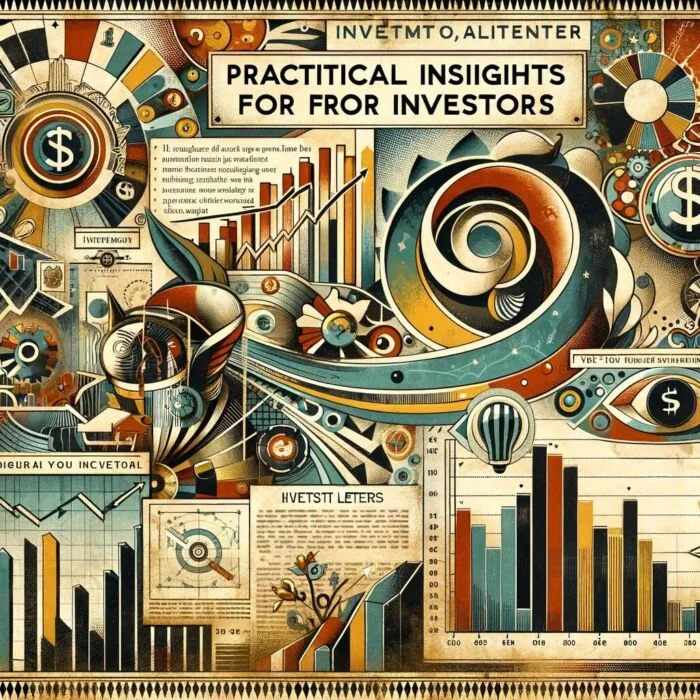Ah, Warren Buffett, the Oracle of Omaha, the champion of value investing, the maestro of the market! This isn’t just a man, ladies and gentlemen; this is a titan of industry, a beacon in the sometimes foggy world of finance. Buffett is not only one of the world’s most successful investors but also one of its greatest teachers. With a net worth skyrocketing in the billions and a lifetime of wisdom, his words carry an unmistakable weight.

One of the ways he shares his knowledge, his philosophy, and the warm wit that he is so known for, is through his annual letters to the shareholders of Berkshire Hathaway, his multi-industry holding company. These aren’t just letters, mind you. They’re masterclasses in investing and business, punctuated with Buffett’s humor and humanity. They’re time capsules, capturing the company’s performance, the economy’s landscape, and Buffett’s invaluable insights into investing and life itself.

Importance of Understanding These Letters for Investors
Now, you might wonder, “Why should I, an individual investor, pay attention to these letters? Aren’t they just for the shareholders of Berkshire Hathaway?” Ah, dear reader, this is where the magic lies! Buffett’s annual letters are a treasure trove for investors, irrespective of whether you own a piece of Berkshire Hathaway. They encapsulate wisdom and strategies that transcend the boundaries of Berkshire and provide insights that can shape your investing journey.
Reading and understanding these letters isn’t just about decoding financial jargon or tracing the trajectory of Berkshire Hathaway. It’s about distilling the wisdom of one of the greatest investors of our time. It’s about learning from his successes, understanding his failures, and garnering the pearls of wisdom he so generously shares. It’s about equipping yourself with a compass as you navigate the sometimes tumultuous seas of the financial world.
So, sit back, grab a cup of your favorite beverage, and join us as we dive deep into the world of Warren Buffett’s annual letters. We promise it will be an exciting journey, filled with nuggets of knowledge, insights into investing, and perhaps even a few laughs along the way. Are you ready? Let’s get started!

The Significance of Warren Buffett’s Annual Letters
Warren Buffett’s annual letters are not your typical corporate correspondence. They are not filled with impenetrable jargon or inscrutable acronyms. Instead, they are beautifully simple, refreshingly honest, and warmly personable – much like the man himself.
Buffett has an uncanny ability to distill complex financial concepts into understandable, even delightful prose. He writes not as a high-flying CEO to his distant shareholders, but as a wise mentor imparting lessons to eager learners. The charm of his Midwestern humor shines through his words, illuminating the path to financial wisdom. His ability to blend anecdotes, humor, and lessons into a cohesive and enjoyable narrative is something to behold.
Every letter reflects Buffett’s immense wisdom – hard-earned over decades of navigating the ups and downs of the market. He generously shares his insights into the world of investing, the state of the economy, and the performance of Berkshire Hathaway. But beyond the numbers and the strategies, Buffett’s letters offer deeper wisdom about patience, risk management, and ethical business conduct. They remind us that investing is not a get-rich-quick scheme, but a long-term commitment that requires diligence, patience, and a deep understanding of businesses.

Why These Letters are a Must-Read for Investors
Buffett’s annual letters are a goldmine for anyone interested in investing, business, or the art of decision-making. They offer a window into the mind of one of the most successful investors of our time, providing a unique perspective on markets, economies, and companies.
Reading these letters can enrich your understanding of value investing, a strategy Buffett swears by. They emphasize the importance of investing in businesses that are undervalued, well-managed, and have a competitive edge – all principles that can guide your investment decisions. They also shed light on how Buffett evaluates businesses, his approach to risk, and his commitment to maintaining a margin of safety.
But perhaps the most crucial reason these letters are a must-read is because they humanize investing. They take it from being a cold, numbers-driven process to an art that requires understanding, patience, and a dash of humor. They remind us that at the heart of investing lies businesses and people, not just stock prices and market indices.
In the end, these letters are not just lessons in investing; they’re lessons in life. They’re about the importance of honesty, the value of patience, and the rewards of diligence. They’re about making decisions based on understanding and not speculation. And in our fast-paced, often short-sighted world, these are lessons we all could benefit from. So whether you’re a seasoned investor, a novice, or someone just interested in understanding business and life a little better, Buffett’s letters are a must-read.
source: Earn Your Leisure on YouTube

Warren Buffett’s Investment Philosophy
Let’s delve a bit into the mind of the maestro, shall we? At the heart of Buffett’s investment philosophy lies the concept of ‘value investing’. The term itself might seem a tad academic, but in reality, it’s as simple and profound as the man himself.
Value investing, in essence, is about spotting diamonds in the rough – finding businesses that are intrinsically valuable but undervalued in the market for one reason or another. But don’t mistake this for a hunt for ‘cheap’ stocks. No, no! Buffett isn’t about picking up stocks for a steal; he’s about buying quality businesses at a reasonable price. It’s not about what’s trendy or flashy; it’s about businesses that have a solid foundation, that provide essential products or services, and that are likely to continue doing so in the future.
In his letters, Buffett often likens buying stocks to owning a piece of the business. This is an essential mindset shift that distinguishes the great investors from the good ones. When you start looking at stocks as businesses, your approach to investing changes. You move from chasing price trends to understanding business fundamentals. You start to look at the management’s quality, the company’s competitive advantage, and its future prospects.
The Importance of a Long-term Investment Perspective
Patience, dear reader, is not just a virtue in life; it’s a superpower in investing. And this is a theme that reverberates through Buffett’s letters.
In the world of 24/7 news cycles and real-time trading, it’s easy to get swept up in the frenzy of short-term thinking. But Buffett, oh wise one, advises otherwise. He’s a champion of long-term investing, of looking beyond the noise and focusing on the music.
Buffett’s investment decisions are driven not by stock market predictions or short-term trends, but by the long-term potential of a business. He believes in investing in companies that will stand the test of time, companies whose value will grow over the years, not just over the quarters. His annual letters often underscore the importance of staying the course, of being patient, and of resisting the urge to react to every market swing.

The Concept of ‘Margin of Safety’
Finally, let’s talk about the ‘margin of safety’, a term you’ll come across quite a few times in Buffett’s letters. This concept is not just central to his investment philosophy; it’s a principle that has saved him (and can save us) from many a financial mishap.
The ‘margin of safety’ is essentially a buffer that investors use to protect themselves against errors in estimation or unforeseen market events. In other words, it’s the difference between the intrinsic value of a stock and its market price. Buffett likes to invest in businesses when their market price is significantly lower than their intrinsic value, giving him a substantial ‘margin of safety’.
This principle allows Buffett to limit his downside risk. It gives him the confidence to invest large sums in businesses, knowing that even if things don’t go exactly as planned, he has a safety net in place.
So there you have it – the cornerstones of Buffett’s investment philosophy. Value investing, long-term perspective, and margin of safety. These are not just principles that guide his investing; they are timeless wisdom that can guide us in making better decisions, in investing and beyond.
source: Dividend Data on YouTube

Key Takeaways from Buffett’s Annual Letters Over the Years
Let’s take a stroll down memory lane, shall we? Over the decades, Warren Buffett has penned countless words of wisdom in his annual letters. Here are some key takeaways that stand out:
- The 1984 Letter: In this gem, Buffett stresses the importance of focusing on a company’s long-term economic performance rather than short-term market fluctuations. This is the letter where he famously said, “In the short term, the market is a voting machine but in the long term, it is a weighing machine.” This is a timeless reminder not to get swayed by market hype and to focus on the fundamental value of a business.
- The 1990 Letter: This one features a masterclass in corporate debt. Buffett cautions about the dangers of over-leverage and the importance of having a strong balance sheet. He advises that “Good jockeys will do well on good horses, but not on broken-down nags.” This is a powerful metaphor stressing the importance of investing in companies with strong financial health, not just good management.
- The 2001 Letter: Here, Buffett discusses the concept of economic moats – the sustainable advantages that protect a company from competition. He says, “The key to investing is not assessing how much an industry is going to affect society, or how much it will grow, but rather determining the competitive advantage of any given company and, above all, the durability of that advantage.” This advice underscores the importance of looking for companies that can defend their turf in the long run.

How Buffett’s Views Evolved Over the Years
What’s truly fascinating about Buffett’s letters is that they aren’t a static collection of wisdom; they’re a dynamic evolution of an investment philosophy. Over the years, you can see Buffett’s views mature, expand, and sometimes, pivot.
Take, for example, his stance on technology stocks. For many years, Buffett avoided investing in technology companies, famously stating in his 1990 letter that he’d rather invest in “understandable” businesses. However, in recent years, we’ve seen a shift. His substantial investment in Apple indicates a more open approach to technology companies, demonstrating his ability to evolve with the changing business landscape.
Similarly, his views on share buybacks have evolved. Initially, Buffett wasn’t a big fan of companies repurchasing their shares. But more recently, he has shown more appreciation for this practice, stating in his 2020 letter that well-timed buybacks can be a valuable tool for enhancing shareholder value.
This evolution of Buffett’s views is a testament to his ability to learn, adapt, and stay relevant in a changing world. And this, dear reader, is perhaps the most valuable lesson from his letters – the importance of staying humble, staying curious, and never stopping learning. After all, in the words of the Oracle of Omaha himself, “What counts for most people in investing is not how much they know, but rather how realistically they define what they don’t know.

Case Studies: Buffett’s Investment Decisions as Discussed in His Letters

Warren Buffett’s investment decisions have always been insightful, and his annual letters to Berkshire Hathaway shareholders provide a deep well of wisdom for us to drink from. Let’s review some of the key investment decisions and strategies he discussed in his letters.
- The Coca-Cola Investment (1988): This is perhaps one of Buffett’s most renowned investments. He noticed that the company had a strong brand and a product with global appeal. He famously remarked, “I like to bet on sure things,” and his $1 billion investment in Coca-Cola was predicated on the simple idea that people will continue to consume sugary drinks.
- Purchase of See’s Candies (1972): This was an early demonstration of Buffett’s affection for companies with durable competitive advantages, or “economic moats.” See’s was a regional brand with the ability to raise prices without losing customers. It was this investment that helped shape Buffett’s approach to value investing, emphasizing quality over cheapness.
- Investment in American Express (1964): After the company was involved in the “Salad Oil Scandal,” its shares plummeted. Despite this, Buffett, understanding the value of the company’s brand and its business model, bought a 5% stake. This investment was a prime example of his ability to remain calm during periods of market turbulence and exploit others’ irrational fear.
- Acquisition of Burlington Northern Santa Fe (BNSF) Railway (2009): In the midst of the global financial crisis, Buffett purchased the rest of BNSF that he didn’t already own, describing it as an “all-in wager on the economic future of the United States.” This long-term view of investing is a hallmark of Buffett’s philosophy.

Lessons Learned from these Decisions
- Invest in What You Understand: Buffett’s decision to invest in Coca-Cola was based on a simple premise: people enjoy Coke and will likely continue to do so. It wasn’t predicated on complex financial models or predictions of the future, but rather a deep understanding of the product and the consumer. This highlights the importance of investing in industries and businesses that you understand thoroughly.
- Look for Companies with Economic Moats: Buffett’s investment in See’s Candies taught us the power of an “economic moat,” a term he popularized. Companies with strong brands, customer loyalty, or other unique competitive advantages can maintain or grow profits in the face of competition. Look for these characteristics in businesses you’re considering investing in.
- Be Fearful When Others Are Greedy and Greedy When Others Are Fearful: Buffett’s American Express investment following the “Salad Oil Scandal” showcases his contrarian approach to investing. He capitalized on the market’s overreaction, recognizing that the core business of American Express remained intact and valuable. This decision underscores the importance of maintaining emotional discipline and taking a contrarian approach when warranted.
- The Long-Term View: Buffett’s acquisition of BNSF Railway, despite the economic turmoil of 2009, displayed his commitment to long-term investing. He wasn’t dismayed by short-term fluctuations or negative sentiment. Instead, he recognized the integral role rail transport plays in the economy and predicted its stable growth. This lesson reinforces the idea that investing is a marathon, not a sprint.
These examples encapsulate Buffett’s pragmatic, long-term, value-oriented approach to investing. His decisions are grounded in solid understanding, diligent research, and a staunch resistance to market frenzy. He’s not trying to predict the market’s next move; instead, he’s always looking for valuable companies at a reasonable price. His letters do not merely recount Berkshire Hathaway’s performance; they are invaluable compendiums of financial wisdom and knowledge, providing insights into the mindset and strategies of one of the world’s most successful investors.
Buffett’s investment decisions are often counter-intuitive, capitalizing on opportunities overlooked or shunned by others. He underscores the importance of patience and discipline, refusing to be swayed by the clamor of the market or the trends of the moment. Even when things seem dire, as they did during the 2008-2009 financial crisis, Buffett saw potential where others saw ruin. His confidence in the enduring strength and resilience of the American economy led him to make a massive investment in BNSF, which has paid off handsomely in the years since.
Buffett’s letters also impart the lesson that value investing is not merely about finding cheap companies; it’s about finding good companies at a reasonable price. His acquisition of See’s Candies, and the subsequent success of that investment, taught him (and us) that quality often trumps price. A great company at a fair price is better than a fair company at a great price, as he frequently points out.
Moreover, Buffett’s unwavering commitment to his principles, despite market fluctuations, exemplifies the temperament needed for successful investing. He possesses a cool head, an analytical mind, and an almost uncanny ability to separate signal from noise in the investing world.
Finally, it’s important to remember that while Buffett’s investment decisions have often been brilliant, they’re not infallible. He’s made mistakes, and he’s been forthright about them in his letters, too. These missteps, as much as the triumphs, form the basis for some of the most valuable lessons. For instance, his ill-timed investment in the airline industry in the late 1980s, which he later referred to as a “mistake,” taught him (and us) about the dangers of investing in capital-intensive businesses with thin profit margins.
In conclusion, Warren Buffett’s annual letters offer a masterclass in sound, principled investing. They reveal a man who combines a profound understanding of business with a deep sense of ethics. His investment decisions are not merely transactions aimed at making a quick buck, but long-term commitments based on solid, understandable business fundamentals, patience, and a dash of contrarianism. Buffett is not just a great investor; he is, as his letters reveal, a great teacher whose lessons continue to educate and inspire investors around the world.
source: iValue Investing on YouTube

Practical Insights for Investors from Buffett’s Letters
Warren Buffett’s letters offer a treasure trove of practical advice and insights that individual investors can harness in their investment journeys. His wisdom is approachable and applicable, whether you’re a novice investor or an experienced one. Here’s how you can apply the wisdom from these letters:
- Understand the Business: Buffett emphasizes time and again the importance of investing in businesses that you understand. As an individual investor, stick to industries and companies you know well or are willing to learn about. Don’t let the hype of the latest tech trend or hot sector cloud your judgment if you don’t truly understand the underlying business model and financials.
- Be Patient: Buffett is a proponent of long-term investing. His buy-and-hold strategy underpins many of his most successful investments. Instead of chasing short-term gains, focus on companies with solid fundamentals and growth prospects over a period of years or even decades. Ignore the noise of market fluctuations and focus on the intrinsic value of the businesses you invest in.
- Look for Economic Moats: An economic moat is a business’s ability to maintain competitive advantages over its competitors in order to protect its long-term profits and market share from competing firms. Look for companies with strong brand identities, customer loyalty, proprietary technology, efficient scale, or other unique attributes that differentiate them from the competition.
- Maintain Emotional Discipline: Don’t let fear or greed drive your investment decisions. Market downturns and economic crises can create buying opportunities for patient investors who keep their cool. Conversely, don’t get carried away in bull markets and overpay for stocks.
- Value Investing: Aim to buy businesses for less than they’re worth. This principle, at the heart of Buffett’s approach, requires thorough analysis to estimate a company’s intrinsic value and a willingness to wait for the market to offer the right price. This strategy can help mitigate risk and maximize returns over the long term.

The Importance of Understanding Businesses and Markets
A consistent theme across Buffett’s letters is the importance of understanding businesses and markets. Here’s why this is critical:
- Identifying Great Businesses: By deeply understanding a business, you’re better positioned to identify its strengths, weaknesses, opportunities, and threats. You can see beyond the financials to understand its operational efficacy, market positioning, competitive landscape, and growth prospects.
- Assessing Intrinsic Value: Understanding a business is crucial for determining its intrinsic value – what it’s truly worth. This involves analyzing financial statements, understanding the industry and the company’s competitive position, evaluating the management team, and making projections about the company’s future cash flows. This assessment helps you make informed decisions about whether a stock is undervalued or overvalued.
- Understanding Market Cycles and Sentiments: Buffett often speaks of being “fearful when others are greedy and greedy when others are fearful.” This requires a nuanced understanding of market sentiments and cycles. When you understand how markets work, you’re better equipped to spot opportunities in market overreactions and avoid herd mentality.
- Risk Management: Understanding the business you’re investing in and the market it operates in helps you manage risk. If you know the business well, you can anticipate potential issues and assess how well-prepared the business is to handle them.
- Long-term Strategy: An in-depth understanding of a business aids in long-term investment planning. It helps you spot businesses that can withstand market volatility and come out stronger. These are the businesses that make successful long-term investments.
Buffett’s letters remind us that investing is as much an art as it is a science. It demands not just financial acumen but also curiosity, patience, and emotional intelligence. The core of Buffett’s wisdom revolves around understanding what you’re investing in, whether it’s a business, a piece of real estate, or a commodity.
For individual investors, the fundamental task is to know the business and market landscape inside out. What does the business do? How does it make money? Who are its competitors? What’s its competitive advantage? Where is the industry headed, and how is the business positioned to adapt to changes?
Buffett’s investment in Coca-Cola exemplifies this principle. He understood the product’s universal appeal, the strength of the brand, and the resilience of the business model. This understanding wasn’t derived from complex mathematical models, but rather from simple, straightforward business analysis and common sense. He grasped that regardless of market volatility and economic downturns, people would continue to buy Coca-Cola. This simplicity is a hallmark of his approach.
On the other hand, understanding markets is about more than just recognizing trends and patterns. It’s about understanding human psychology, sentiments, and behaviors. It’s about realizing that markets can be irrational, driven by fear or greed, and that they often overshoot or undershoot a company’s true value. Buffett’s investment in American Express after the Salad Oil Scandal is a testament to his grasp of market psychology.
Moreover, understanding businesses and markets forms the bedrock of risk management. The better you understand a business, the better you can gauge its risk and potential return. Buffett’s letters emphasize the importance of avoiding permanent capital loss, which requires a clear-eyed assessment of potential risks. This principle was central to his investment in BNSF, where he saw the enduring importance of rail transportation and the company’s strong competitive position.
Finally, Buffett’s letters underscore that understanding businesses and markets is key to successful long-term investing. It allows investors to identify companies with durable competitive advantages—what Buffett often refers to as “economic moats”—and to hold onto these investments through market ups and downs. This long-term view is embodied in Buffett’s investment in See’s Candies, which he has held for over five decades and counting.
The wisdom from Buffett’s letters emphasizes the importance of understanding businesses and markets. It encourages investors to dig deep, ask questions, and think long-term. The true beauty of this wisdom is that it’s not just for Wall Street wizards—it’s equally applicable for individual investors, offering a roadmap for making thoughtful, informed, and successful investment decisions.
source: We Study Billionaires on YouTube
Conclusion: Importance and wisdom of Buffett’s annual letters

Warren Buffett’s annual letters to the shareholders of Berkshire Hathaway are more than just corporate communications. They are, in essence, a distillation of the wisdom gleaned from one of the most successful investment careers in history. The importance of these letters cannot be overstated; they offer invaluable insights into the mind of a financial luminary, providing guidance, inspiration, and practical advice to investors around the globe.
These letters encapsulate the simplicity and elegance of Buffett’s investment philosophy, which can be summarized in a few key principles: Understand the business you’re investing in, seek companies with durable competitive advantages, be patient and invest for the long term, maintain emotional discipline in the face of market volatility, and buy businesses at a price below their intrinsic value.
Beyond these principles, Buffett’s letters are also notable for their clarity, humility, and humor. He manages to make complex financial concepts accessible to everyday investors, demonstrating that one doesn’t need to be a Wall Street whiz to succeed in investing. His forthrightness about his mistakes is as refreshing as it is instructive, reminding us that even the best investors are fallible and that there is often as much to learn from missteps as from triumphs.

Continued Learning from Buffett’s Wisdom and Experiences
In a world of fast money and constant market noise, Buffett’s wisdom offers a timeless reminder of the enduring principles of sound investing. His experiences, as detailed in his letters, provide a road map for investors to navigate the complex terrain of the investment world. But it’s crucial to remember that Buffett’s wisdom is not a get-rich-quick scheme, and it’s not about copying his investments. Instead, it’s about understanding and applying the principles that guide his investment decisions.
I encourage every investor to delve into the treasure trove of knowledge that Buffett’s letters offer. Each letter is a lesson in patience, diligence, and humility. They remind us that successful investing is not about predicting the future or timing the market, but about thoughtful analysis, disciplined decision-making, and unshakeable patience.
Don’t rush through the letters. Take your time to absorb the wisdom they contain, to reflect on the principles they embody, and to consider how these principles can be applied to your own investment journey. Remember, too, that learning from Buffett is not just about studying his successes; it’s also about understanding his failures and the lessons he gleaned from them.
While the specifics of Buffett’s investments may change over time, the fundamental principles that guide his decisions remain the same. These principles—understanding a business, seeking economic moats, maintaining patience, keeping emotional discipline, and focusing on value—are as relevant today as they were when Buffett started his career. They’ll continue to be relevant no matter how much the investment landscape changes.
In conclusion, I encourage you to embark on or continue your journey of learning from Buffett’s wisdom and experiences. Allow the lessons from his letters to guide you, inspire you, and ground you. As you navigate the world of investing, let Buffett’s principles be your North Star, reminding you that success in investing, as in life, comes not from chasing after quick wins, but from patient and disciplined adherence to timeless principles. Remember, in Buffett’s own words: “Investing is not a game where the guy with the 160 IQ beats the guy with the 130 IQ. Once you have ordinary intelligence, what you need is the temperament to control the urges that get other people into trouble in investing.”
Important Information
Comprehensive Investment Disclaimer:
All content provided on this website (including but not limited to portfolio ideas, fund analyses, investment strategies, commentary on market conditions, and discussions regarding leverage) is strictly for educational, informational, and illustrative purposes only. The information does not constitute financial, investment, tax, accounting, or legal advice. Opinions, strategies, and ideas presented herein represent personal perspectives, are based on independent research and publicly available information, and do not necessarily reflect the views or official positions of any third-party organizations, institutions, or affiliates.
Investing in financial markets inherently carries substantial risks, including but not limited to market volatility, economic uncertainties, geopolitical developments, and liquidity risks. You must be fully aware that there is always the potential for partial or total loss of your principal investment. Additionally, the use of leverage or leveraged financial products significantly increases risk exposure by amplifying both potential gains and potential losses, and thus is not appropriate or advisable for all investors. Using leverage may result in losing more than your initial invested capital, incurring margin calls, experiencing substantial interest costs, or suffering severe financial distress.
Past performance indicators, including historical data, backtesting results, and hypothetical scenarios, should never be viewed as guarantees or reliable predictions of future performance. Any examples provided are purely hypothetical and intended only for illustration purposes. Performance benchmarks, such as market indexes mentioned on this site, are theoretical and are not directly investable. While diligent efforts are made to provide accurate and current information, “Picture Perfect Portfolios” does not warrant, represent, or guarantee the accuracy, completeness, or timeliness of any information provided. Errors, inaccuracies, or outdated information may exist.
Users of this website are strongly encouraged to independently verify all information, conduct comprehensive research and due diligence, and engage with qualified financial, investment, tax, or legal professionals before making any investment or financial decisions. The responsibility for making informed investment decisions rests entirely with the individual. “Picture Perfect Portfolios” explicitly disclaims all liability for any direct, indirect, incidental, special, consequential, or other losses or damages incurred, financial or otherwise, arising out of reliance upon, or use of, any content or information presented on this website.
By accessing, reading, and utilizing the content on this website, you expressly acknowledge, understand, accept, and agree to abide by these terms and conditions. Please consult the full and detailed disclaimer available elsewhere on this website for further clarification and additional important disclosures. Read the complete disclaimer here.





